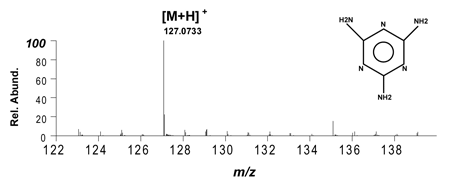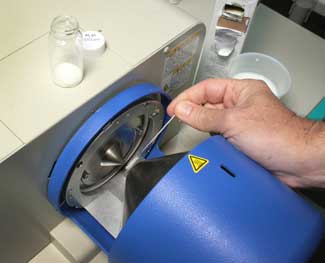October 29, 2008 – Peabody, Mass. - First it was pets, now it is babies who have died from ingesting food tainted with melamine. Detection of this chemical compound, which is being maliciously added to food products to make them appear to contain higher levels of protein, takes on a new urgency in a global market.
A rapid screening technique that has been widely used for instant analysis without sample preparation has just been proven as a viable means of detecting melamine in food. Chemists at JEOL USA in Peabody, Mass. have published an applications report entitled “Rapid Detection of Melamine in Dry Milk Using AccuTOF-DART™.”

The findings demonstrate that using Direct Analysis in Real Time (DART) open-air ionization, researchers can rapidly and accurately screen suspected foods for melamine without using time-consuming techniques. The JEOL AccuTOF-DART readily analyzed a mixture of powdered milk and melamine to obtain data in mere seconds. The DART detected melamine at levels well below the United States Food and Drug Administration’s (FDA) maximum allowable concentration of 2.5 ppm.
Earlier this year, the FDA's Forensic Chemistry Center (FCC) reported that researchers had initially detected melamine in pet food using the DART open-air ionization method. The University of the Pacific also used the DART and published its findings in the Journal of Analytical Toxicology after successful analysis of dog food during the original recall of pet foods in April 2007 (www.jatox.com/abstracts/2007/July/304-sparkman.html).
Unlike other analytical techniques, the AccuTOF-DART methodology does not require time-consuming extractions or chromatographic methods to detect melamine in dry milk or other food products. The analysis was carried out by simply dipping a melting point tube into the mixtu re and then dangling the glass rod in front of the DART sensor. Within seconds of sampling the tainted milk powder, the AccuTOF-DART provided exact masses and isotopic data to identify melamine at levels between 500 ppb and 1000 ppm.
re and then dangling the glass rod in front of the DART sensor. Within seconds of sampling the tainted milk powder, the AccuTOF-DART provided exact masses and isotopic data to identify melamine at levels between 500 ppb and 1000 ppm.
The JEOL applications note and information on the University of the Pacific’s paper on melamine can be found on the JEOL USA website at www.jeolusa.com.
About the JEOL AccuTOF-DART
JEOL’s AccuTOF-DART, introduced and made commercially available in 2005, has gained recognition as a fast, accurate method of directly analyzing materials and chemical compounds. What sets it apart from traditional or other novel mass spectrometry methods is its ability to analyze the chemicals directly from the sample, i.e. paper, clothing, liquids or gases, without sample preparation and without altering the sample in any way – in other words, valuable forensic evidence can remain intact.
Because of the instant analytical results, the AccuTOF-DART has not only found a niche among crime labs, it is used for chemical and drug manufacturing, identifying unknown materials, detecting counterfeit anti-malarial drugs, monitoring chemical reactions, and more.
With this technique chemists can measure high-resolution, accurate mass spectra by simply placing a sample in its native form, between the DART ion source and the AccuTOF mass spectrometer inlet. The AccuTOF-DART couples the facile operation of the DART ion source with the high-resolution, accurate mass capability of the AccuTOF time-of-flight mass spectrometer. So not only can you rapidly acquire data for mixtures and complete unknowns without sample carryover, but the resulting spectra yield clear assignments, isotopic ratios and elemental compositions. For even more sampling versatility, the standard configuration also includes an orthogonal electrospray (ESI) source. The revolutionary AccuTOF-DART exponentially improves the mass spec workflow.